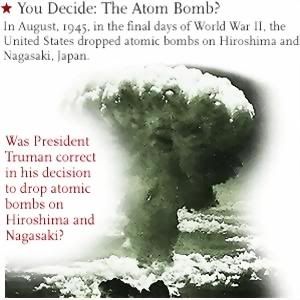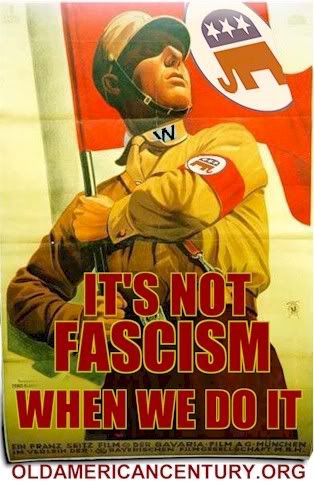About 80,000 people were killed in a split second in Hiroshima. Five months later, more than 70,000 others died from radiation and injuries. Three days after Hiroshima's attack, the U.S. dropped another nuclear bomb on Nagasaki, killing more than 70,000 people before the year end.

Since 1945, tens of thousands more citizens of both cities have continued to suffer and die.
A small group of U.S. leaders met secretly in Washington and ordered this horrible attack on civilian populations. They gave no explicit warnings, and they refused all options, preferring to cause the most extreme human carnage possible. They decided to carry out the worst two terror attacks in human history.
The British New Scientist magazine uncovered new evidence when it said on July 21 that two historians revealed that ''the U.S. decision to drop atomic bombs on Hiroshima and Nagasaki ... was meant to kick-start the Cold War against the Soviet Union, rather than end the Second World War''.
Peter Kuznick, director of the Nuclear Studies Institute at the American University in Washington, said that the U.S. President Harry Truman's decision to attack the cities "was not just a war crime, it was a crime against humanity''.
Kuznick examined the diplomatic archives of the U.S., Japan and the USSR with Mark Selden, a historian from Cornell University in New York.
They revealed that three days before Hiroshima, Truman agreed that Japan was ''looking for peace''. His top aides and political advisers told him there was no need to use the atomic bomb. But he ordered the attack.

Harry S. Truman, the thirty-third President of the United
States (1945-1953).A war criminal like the majority of the American Presidents , which were never prosecuted to the International Court of Hague.
Many political analysts say that Truman only wanted to revenge for Pearl Harbor, and wanted to demonstrate Washington's strategic power.
''Impressing Soviet Union was more important than ending the war'', Selden told the New Scientist.
At a conference organized by Greenpeace in London to mark the 60th anniversary of the bloody attacks, Selden also said that "there was a belief that dropping the bomb could accelerate the end of the war in ways that would greatly strengthen the American strategic position in Asia,"
"This was in fact a race with the Soviets. The bomb was to announce to the world American superiority. It would also stop any Soviet advance against Japan and create a situation, as happened, in which the U.S. would dominate the occupation of Japan."
While the capitalist media immediately described the historians' theory as ''controversial'', it accords with the testimony of several central U.S. political and military officials at the time, including General Dwight Eisenhower, who said in a 1963 Newsweek interview that ''the Japanese were ready to surrender and it wasn't necessary to hit them with that awful thing''.
Truman's chief of staff, Admiral William Leahy, also said in his memoirs that ''the use of this barbarous weapon at Hiroshima and Nagasaki was of no material assistance in our war against Japan. The Japanese were already defeated and ready to surrender.''
However, the U.S. decided at the time to obliterate the lives of hundreds of thousands of men, women and children to show off the power of its new super weapon and indicate that it can use it whenever it wanted.

These terrible attacks were aimed at warning the leaders of the Soviet Union that their cities could face the same fate if the USSR tried to stand in the way of Washington's plans to create an ''American Century'' of U.S. global domination.
Nuclear scientist Leo Szilard told his biographers how Truman's secretary of State, James Byrnes, told him before the Hiroshima attack that ''Soviet Union might be more manageable if impressed by American military might and that a demonstration of the bomb may impress Soviet Union''.
Proud of the success of its nuclear attacks in Japan, the U.S. threatened to drop atomic weapons on more than 20 occasions in the 1950s and 1960s. But it backed off when the USSR developed enough nuclear-armed missiles to enter the era of ''mutually assured destruction'', and the U.S. leaders' feared that their use of atomic arms would lead to a huge anti-U.S. political revolt by ordinary people around the world.
However, the U.S.'s policy of nuclear terror remains intact. It refuses to rule out the use of nuclear arms in a conflict. Its latest Nuclear Posture Review underlines the use of nuclear weapons against non-nuclear ''rogue states'' and it is working on a new generation of ''battlefield'' atomic arms.
Fear of the political backlash remains the main restraint upon the atomaniacs in the United States.

The clock of a victim stoped at the time that the bomb was droped in Hiroshima.It belonged to Kengo Futagawa ,a 59 old man,who was crossing the Kannon Bridge (1,600 meters from the hypocenter of the bomb) by bicycle on his way to do fire prevention work.
He jumped into the river, terribly burned. He returned home, but died on August 22, 1945.
On the 60th anniversary of the worst terror attacks in history, the useful action that peace-loving people can take is to strengthen that fear and revive it in the minds of the fascist, butcher Americans ,and their satelite puppet states,who have the impudence and audacity to label others as ''terrorist''.


Since 1945, tens of thousands more citizens of both cities have continued to suffer and die.
A small group of U.S. leaders met secretly in Washington and ordered this horrible attack on civilian populations. They gave no explicit warnings, and they refused all options, preferring to cause the most extreme human carnage possible. They decided to carry out the worst two terror attacks in human history.
The British New Scientist magazine uncovered new evidence when it said on July 21 that two historians revealed that ''the U.S. decision to drop atomic bombs on Hiroshima and Nagasaki ... was meant to kick-start the Cold War against the Soviet Union, rather than end the Second World War''.
Peter Kuznick, director of the Nuclear Studies Institute at the American University in Washington, said that the U.S. President Harry Truman's decision to attack the cities "was not just a war crime, it was a crime against humanity''.
Kuznick examined the diplomatic archives of the U.S., Japan and the USSR with Mark Selden, a historian from Cornell University in New York.
They revealed that three days before Hiroshima, Truman agreed that Japan was ''looking for peace''. His top aides and political advisers told him there was no need to use the atomic bomb. But he ordered the attack.

Harry S. Truman, the thirty-third President of the United
States (1945-1953).A war criminal like the majority of the American Presidents , which were never prosecuted to the International Court of Hague.
Many political analysts say that Truman only wanted to revenge for Pearl Harbor, and wanted to demonstrate Washington's strategic power.
''Impressing Soviet Union was more important than ending the war'', Selden told the New Scientist.
At a conference organized by Greenpeace in London to mark the 60th anniversary of the bloody attacks, Selden also said that "there was a belief that dropping the bomb could accelerate the end of the war in ways that would greatly strengthen the American strategic position in Asia,"
"This was in fact a race with the Soviets. The bomb was to announce to the world American superiority. It would also stop any Soviet advance against Japan and create a situation, as happened, in which the U.S. would dominate the occupation of Japan."
While the capitalist media immediately described the historians' theory as ''controversial'', it accords with the testimony of several central U.S. political and military officials at the time, including General Dwight Eisenhower, who said in a 1963 Newsweek interview that ''the Japanese were ready to surrender and it wasn't necessary to hit them with that awful thing''.
Truman's chief of staff, Admiral William Leahy, also said in his memoirs that ''the use of this barbarous weapon at Hiroshima and Nagasaki was of no material assistance in our war against Japan. The Japanese were already defeated and ready to surrender.''
However, the U.S. decided at the time to obliterate the lives of hundreds of thousands of men, women and children to show off the power of its new super weapon and indicate that it can use it whenever it wanted.

These terrible attacks were aimed at warning the leaders of the Soviet Union that their cities could face the same fate if the USSR tried to stand in the way of Washington's plans to create an ''American Century'' of U.S. global domination.
Nuclear scientist Leo Szilard told his biographers how Truman's secretary of State, James Byrnes, told him before the Hiroshima attack that ''Soviet Union might be more manageable if impressed by American military might and that a demonstration of the bomb may impress Soviet Union''.
Proud of the success of its nuclear attacks in Japan, the U.S. threatened to drop atomic weapons on more than 20 occasions in the 1950s and 1960s. But it backed off when the USSR developed enough nuclear-armed missiles to enter the era of ''mutually assured destruction'', and the U.S. leaders' feared that their use of atomic arms would lead to a huge anti-U.S. political revolt by ordinary people around the world.
However, the U.S.'s policy of nuclear terror remains intact. It refuses to rule out the use of nuclear arms in a conflict. Its latest Nuclear Posture Review underlines the use of nuclear weapons against non-nuclear ''rogue states'' and it is working on a new generation of ''battlefield'' atomic arms.
Fear of the political backlash remains the main restraint upon the atomaniacs in the United States.

The clock of a victim stoped at the time that the bomb was droped in Hiroshima.It belonged to Kengo Futagawa ,a 59 old man,who was crossing the Kannon Bridge (1,600 meters from the hypocenter of the bomb) by bicycle on his way to do fire prevention work.
He jumped into the river, terribly burned. He returned home, but died on August 22, 1945.
On the 60th anniversary of the worst terror attacks in history, the useful action that peace-loving people can take is to strengthen that fear and revive it in the minds of the fascist, butcher Americans ,and their satelite puppet states,who have the impudence and audacity to label others as ''terrorist''.


